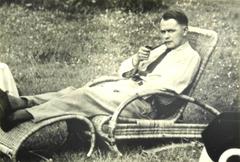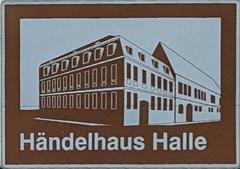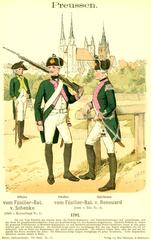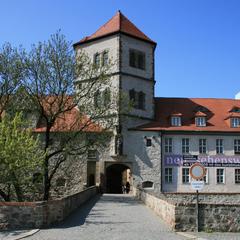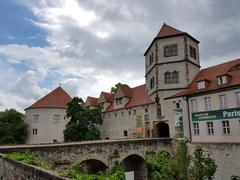Roter Ochse Halle: Comprehensive Visiting Guide, Tickets, Hours, and Historical Overview
Date: 14/06/2025
Introduction
The Roter Ochse Memorial (Gedenkstätte Roter Ochse) in Halle (Saale), Germany, stands as a powerful site of remembrance, reflection, and education. Housed in a striking red-brick former prison, the site chronicles the profound transformations in German justice and politics from the 19th century through the Nazi era, Soviet occupation, and the East German Stasi regime. This guide provides everything you need to plan a respectful and insightful visit, including historical context, practical visitor information, special exhibitions, accessibility details, and recommendations for nearby attractions.
“The Roter Ochse is a monument not only to the suffering endured within its walls but also to the enduring spirit of those who resisted oppression.”
(Frank Falla Archive, bpb.de)
Contents
- History and Cultural Significance
- Visiting Information
- Exhibitions and Educational Programs
- Planning Your Visit
- Frequently Asked Questions (FAQ)
- Contact and Further Information
- Conclusion
- References
History and Cultural Significance
19th Century Foundations
Established in 1842 as a royal Prussian penal institution, the Roter Ochse (“Red Ox”) was conceived with then-progressive ideals of reform and rehabilitation. Its distinctive red-brick structure quickly made it a local landmark. Initially, the prison was part of a broader movement toward correction and rehabilitation, but it soon played a role in major political trials, including the 1885 execution of anarchists August Reinsdorf and Emil Küchler (Frank Falla Archive).
Nazi Era and Political Persecution
The darkest chapter in the Roter Ochse’s history unfolded between 1933 and 1945. Under the Nazi regime, the prison became an instrument of systemic repression. Political prisoners, Jews, and other persecuted groups were incarcerated here, with the site serving as a facility for “Schutzhaft” (protective custody). Starting in 1942, executions by guillotine took place within its walls; over 540 people were executed by the Nazi judiciary (bpb.de).
Postwar, Soviet, and Stasi Use
After 1945, the Roter Ochse was repurposed by Soviet authorities as a detention center, and later, until 1989, by the East German Ministry for State Security (Stasi) as a remand prison. Nearly 10,000 individuals were detained during this period, many for political reasons. Today, the memorial preserves this complex legacy, serving as a place of remembrance and critical reflection (gedenkstaette-halle.sachsen-anhalt.de).
Visiting Information
Opening Hours
- Monday & Friday: 10:00–14:00
- Tuesday–Thursday: 10:00–16:00
- First Weekend of Each Month (Sat & Sun): 13:00–17:00, with public guided tours at 14:00
- Closed on public holidays (except October 3rd, German Unity Day)
Always verify current hours on the official memorial website before your visit.
Tickets and Guided Tours
- Admission: Free for all visitors, including special exhibitions. No reservation or ticket is required for individual visits (dreisteine.com).
- Public Guided Tours: Offered on the first Saturday and Sunday each month at 14:00. These tours are in German, but English tours can be arranged with advance notice.
- Private/Group Tours: Available by pre-booking via phone or email.
Accessibility
- The site is largely wheelchair accessible, with ramps and elevators in key areas.
- Some historic sections may have limited access due to preservation needs. Contact the memorial ahead of time for tailored support (gedenkstaette-halle.sachsen-anhalt.de).
Facilities
- Restrooms are available.
- There is no café on site, but numerous restaurants and cafés are within a short walk in the city center.
- Educational materials and brochures are provided; some exhibition content is available in English.
Exhibitions and Educational Programs
Permanent Exhibitions
- Ground Floor: Focuses on political justice during the Nazi era, including the prison’s role in persecution, the execution facility, and courtrooms used by Nazi authorities.
- Second Floor: Details the Soviet and East German periods, emphasizing political justice, repression, and the experiences of detainees.
Exhibits use original documents, artifacts, photographs, and personal testimonies to convey the human stories behind these historical events.
Special Exhibitions
- “Drei Steine – Graphic Novel gegen Rechts” (Feb 21 – June 4, 2025):
This exhibition, based on Nils Oskamp’s autobiographical graphic novel, explores resistance to right-wing extremism and fosters contemporary political education. Interactive elements, readings, and workshops accompany the display (dreisteine.com, Halle Life Events).
Guided Tours and Events
- Public Tours: First weekend each month at 14:00, no registration needed for individuals.
- Special Events: The memorial hosts educational workshops, commemorations, and panel discussions throughout the year. Check the official website for the latest schedule.
- School and Youth Programs: Tailored tours and workshops available; ideal for grades 7 and up.
Planning Your Visit
How to Get There
- Address: Am Kirchtor 20b, 06108 Halle (Saale), Germany
- Public Transit:
- Tram line 8: “Diakoniewerk Halle” stop (short walk)
- Tram or bus to “Hermannstraße” stop and walk via Hermannstraße to Am Kirchtor
(Halle Tourist Information)
- By Car:
- Limited parking on Am Kirchtor and nearby streets
- Additional parking: “Friedemann-Bach-Platz” via Große Wallstraße (Halle Entdecken)
Nearby Attractions
Enhance your visit by exploring other local highlights:
- Moritzburg Castle and Museum
- Marktkirche Unser Lieben Frauen
- Händel-Haus (Handel House)
- Kunstmuseum Moritzburg
For more recommendations, see The Crazy Tourist.
Visitor Conduct
- Maintain a respectful and contemplative manner, especially in memorial and execution areas.
- Photography is allowed for personal use, but flash and tripods may be restricted.
- Some exhibits contain sensitive content; younger visitors should be accompanied by adults.
- For educational or media use of images, arrange permission in advance.
Frequently Asked Questions (FAQ)
Q: Is admission free?
A: Yes, entry is free for all visitors.
Q: Are guided tours available in English?
A: Some materials are available in English; arrange English-language tours in advance.
Q: Is the memorial accessible for visitors with disabilities?
A: Most areas are accessible, but some historic sections may pose challenges. Contact staff for details.
Q: When are public guided tours offered?
A: At 14:00 on the first Saturday and Sunday of each month.
Q: What are the current special exhibitions?
A: See the official memorial website for up-to-date information.
Contact and Further Information
- Phone: +49 (0)345 470 698 337
- Email: [email protected]
- Website: gedenkstaette-halle.sachsen-anhalt.de
Conclusion
The Roter Ochse Memorial is a site of deep historical resonance and educational value. Through its carefully curated exhibitions, accessible programming, and commitment to remembrance, it invites visitors to confront the legacies of totalitarianism and political injustice in Germany. Plan your visit to engage meaningfully with Halle’s past and contribute to a culture of remembrance and democratic reflection.
For more travel tips, audio guides, and historical insights, download the Audiala app, follow our social channels, and explore related resources.
References
- Frank Falla Archive: Halle Prison
- bpb.de: Gedenkstätte Roter Ochse Halle (Saale)
- dreisteine.com: Roter Ochse Exhibition and Memorial
- gedenkstaette-halle.sachsen-anhalt.de: Official Site

